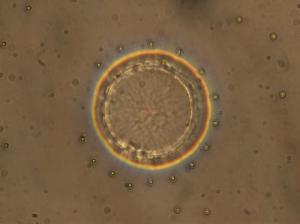Nov 13 2013
An interdisciplinary team of University of Pennsylvania researchers has already developed a technique for controlling liquid crystals by means of physical templates and elastic energy, rather than the electromagnetic fields that manipulate them in televisions and computer monitors. They envision using this technique to direct the assembly of other materials, such as nanoparticles.
 A submerged micropost causes the surrounding nematic liquid crystal to form a ring defect pattern at the post's mid-height. This ring acts a further template, directing nanoparticles on the surface 50 microns away. Credit: PNAS
A submerged micropost causes the surrounding nematic liquid crystal to form a ring defect pattern at the post's mid-height. This ring acts a further template, directing nanoparticles on the surface 50 microns away. Credit: PNAS
Now, the Penn team has added another tool to its directed assembly toolkit, developing a new kind of template for rearranging particles and a new set of patterns that can be formed with them.
The team consists of Kathleen Stebe, the School of Engineering and Applied Science's deputy dean for research and professor in Chemical and Biomolecular Engineering; Randall Kamien, professor in the School of Arts and Sciences' Department of Physics and Astronomy; and Shu Yang, professor in Engineering's departments of Materials Science and Engineering and Chemical and Biomolecular Engineering. Members of their labs also contributed to the new study, including lead author Marcello Cavallaro Jr., Mohamed Gharbi, Daniel Beller, Simon Čopar, Zheng Shi and Tobias Baumgart.
Their work was published in the Proceedings of the National Academy of Science.
Crystals are materials that have molecules arrayed in regular three-dimensional patterns; liquid crystals contain some but not all of these patterns, and their molecules can flow around one another and change the direction they face. This behavior allows defects, places on the surface where the molecular orientation of the liquid crystals is disrupted.
Despite their name, such defects are highly desirable. If the location of the defects can be controlled, the change in pattern or orientation can be put to use. In a liquid crystal display, for example, the crystals' orientation in different regions determines which parts of the screen are illuminated.
In an earlier study, the team had used a template consisting of microscopic posts to arrange the defects on the surface of smectic liquid crystals, a class of the material that forms layers. The position, shape and symmetry of the posts allowed the researchers to manipulate the bottom layer of these liquid crystals which in turn generated patterns of defects on the top layer that were orders of magnitude smaller than the original template.
In their new study, the researchers use nematic liquid crystal, which have less long-range order in their patterns but are the kind found in liquid crystal displays.
"These nematic structures are very reconfigurable. That's the basis of why they're good for displays," Stebe said. "Everyone knew that materials can be moved and positioned with electric and magnetic fields, but we're doing it with fields of elastic energy and showing that this technology can be used in assembling materials."
As in their previous experiments, the team started with a template consisting of microscopic posts that was then topped with the liquid crystal. In this experiment, however, instead of a pattern of defects forming only on the surface of the liquid crystal, a ring-shaped defect encircled each of the posts at their midpoints. This ring then acts like another template, directing the arrangement of patterns on the liquid crystal surface, more than 50 microns away.
"With the smectic liquid crystals," Kamien said, "the patterns of defects we could make were closely associated with the corners of the posts. With nematic liquid crystals, we can form these rings, which is a new way to tell what to go where."
"And we're showing," Yang said, "that, whether we use smectic or nematic crystals, we can use a template that directs these surface defect arrays, which can then hold things like colloids, nanoparticles or quantum dots."
Being able to control the spacing and arrangement of these secondary materials could allow for making new types of antennas, sensors or displays. The team's latest study provides a new set of shapes and patterns to work with in the directed assembly approach to making such devices.
"We're building up the toolkit of the different structures we can make via different confinements of these materials," Stebe said. "Once we have our toolkit filled out, it's going to become more readily apparent how we can make these structures dance — how we can make them rearrange themselves however we want — the next wave of applications will come."
Press release avilable from http://www.eurekalert.org/